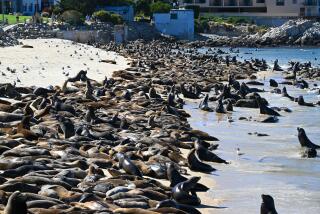Parrots as Free as a Bird
On the Santa Monica Freeway, motorists report a flock of parakeets flying low over morning traffic, like a cloud of green confetti.
In a Los Feliz mini-mall, the appearance of a dozen canary-winged parakeets prompts shoppers to wander into a pet store and ask whether the birds escaped.
In Temple City, neighbors gather on front lawns to watch hundreds of red-crowned parrots roost in shade trees. Their shrieking calls can be heard for blocks around.
Parrot sightings in L.A. have become the stuff of urban legend. The exotic birds appear in flashes of color, flying free in a city that seems entirely inhospitable to creatures usually seen asking for crackers in gilded cages or pedaling tiny bicycles in amusement park shows.
But ornithologists confirm that wild parrots are in fact real, with more than 4,000 now flying and foraging in the wilds of Southern California. No one knows for sure how they got here, but at least 10 varieties are now firmly established in surroundings that provide everything they need to survive and multiply.
“Once you start looking, it’s impossible not to notice them,” says Kimball Garrett, ornithology collections manager at the Natural History Museum of Los Angeles County. As part of a five-year study called the Parrot Project, Garrett has compiled data from more than 1,500 parrot sightings. Despite continued urbanization and a complete ban on imports, Garrett says the local parrot population is booming.
Roosting in palm fronds or under roof tiles, parrots travel long distances to feed on sycamore or eucalyptus leaves, as well as cherries, walnuts, figs, kumquats and magnolia flowers. “They would never survive here if we didn’t plant such exotic trees and shrubs,” Garrett says.
Not much is known about their behavior, Garrett says, because most bird-watchers ignore them. “The same birder who will go to great lengths to study call note subtleties in warblers or flycatchers will dismiss a free-flying parrot as some stupid green thing that came out of a cage,” he says.
Just how the parrots got here remains a mystery. Evaldo Ferreira, who owns Flo’s Pet Store in Los Angeles, insists that the wild parrots--some of which could fetch upward of $5,000 in captivity--were released from aviaries during the Malibu fires two years ago.
But the store’s original owner, Flo Sissons, is certain the birds migrated. “My theory is they flew up from Tijuana,” she says. “If they can’t keep people from coming up, they definitely can’t stop these guys.”
Others believe that smugglers of black market birds regularly release parrots during trips across the border. “I’m sure every one of those stories has some basis in fact,” Garrett says. “But there are probably thousands of events that caused the population to grow like it has.”
While parrots are a colorful addition to urban wildlife, Garrett warns that their arrival should not be romanticized. While it appears that parrots have stayed away from native birds and area crops, no one knows what will happen if their numbers continue to multiply.
But some bird lovers can’t help cheering the parrots on. Sissons says she once spotted a single cockatiel roosting with a group of pigeons.
“They’re used to living in cages, and now all of a sudden they’re up there enjoying life on their own,” Sissons says. “When people tell me their bird got loose, I tell them not to worry. Nature takes care of them. They’re as happy as they can be.”
More to Read
Sign up for Essential California
The most important California stories and recommendations in your inbox every morning.
You may occasionally receive promotional content from the Los Angeles Times.










